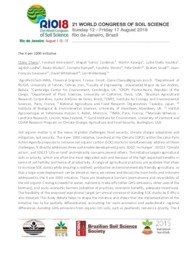The 4 per 1000 initiative.
The 4 per 1000 initiative.
Author(s): CHENU, C.; AMIRASLANI, F.; GARCIA CARDENAS, M.; KAONGA, M.; KOUTIKA, L-S.; LADHA, J.; MADARI, B. E.; RUMPEL, C.; SHIRATO, Y.; SMITH, P.; SOUDI, B.; SOUSSANA, J-F; WHITEHEAD, D.; WOLLENBERG, L.
Summary: Soil organic matter is at the nexus of global challenges: food security, climate change adaptation and mitigation, soil security. The 4 per 1000 initiative, launched at the Climate COP21 within the Lima-Paris Action Agenda proposes to increase soil organic carbon (SOC) stocks to simultaneously address all these challenges. It directly addresses three sustainable development goals: SDG2 ?no hunger?, SDG13 ?Climate action?, and SDG15 ?Life on land? and indirectly concerns several others. The initiative targets agricultural soils in priority, which are often the most degraded soils and because of the high expected benefits in terms of soil fertility and hence of productivity. A range of agricultural practices are available that allow to increase SOC stocks while ensuring a resilient, productive and environmentally friendly agriculture, so that a large-scale deployment can be aimed at. Here, we review and discuss the main limits and criticisms addressed to the 4 per 1000 initiative.
Publication year: 2018
Types of publication: Abstract in annals or event proceedings
Unit: Embrapa Rice & Beans
Observation
Some of Embrapa's publications are published as ePub files. To read them, use or download one of the following free software options to your computer or mobile device. Android: Google Play Books; IOS: iBooks; Windows and Linux: Calibre.
Access other publications
Access the Agricultural Research Database (BDPA) to consult Embrapa's full library collection and records.
Visit Embrapa Bookstore to purchase books and other publications sold by Embrapa.

